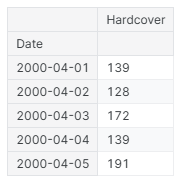You can use so many ML models for forecasting, which makes it overwhelming to choose the best one.
Are you also interested in forecasting but not sure which machine learning algorithm is best suited for your use case?
If that is the case, then this blog will clear up any doubts about different ML algorithms used for forecasting and their pros and cons.

Let’s jump right into it!
In case you are wondering what is forecasting…
In short, forecasting is predicting future trends depending on past trends. The basic object of forecasting is time series.
A time series is a set of observations made over some time. The observations are typically recorded on a regular frequency, such as daily or monthly.

This series records the number of hardcover books sold over 30 days.
Next, let’s look at the ML models for forecasting that are widely used.
What Will You Learn?
ML Models for forecasting
There are multiple models in machine learning that you can use for forecasting. Machine learning models for forecasting are part of any of the three following techniques:
- Time Series
- Regression Analysis
- Deep Learning
Time Series Forecasting Methods
Time series models are statistical tools that experts use to study and predict data that changes over time. These models help us uncover patterns, trends, and relationships in the data, which in turn allows us to make informed predictions about what might happen in the future.
Following are some of the techniques used in time series for forecasting:
- Moving Average (MA) Model
- Autoregressive Model
- Autoregressive Moving Average (ARMA) Model
- Autoregressive Integrated Moving Average (ARIMA) Model
- Seasonal ARIMA Model
- Exponential Smoothing Model
- Vector AutoRegression Model
Pros of Time Series Forecasting
- Accuracy is very high
- Easy to implement
- Can generate a model with few data points. In a case, a minimum of 12 data points were used to generate this model
Cons of Time Series Forecasting
- In a few cases, it fails to identify trends or seasonality
- In some cases, it identifies the incorrect trends and extrapolates the data exponentially
Regression Models for Forecasting
Regression analysis is a way of modeling the dependence of a variable (called the dependent or response variable) on one or more other variables (called the independent or explanatory variables).
For example, you might want to study how a product’s sales depend on the price, the advertising budget, and the season. Regression analysis can help you estimate each factor’s effect on sales and how well you can predict sales based on these factors.
Types of Regression Models:
- Simple Linear Regression:
Examines a linear relationship between one dependent and one independent variable. - Multiple Linear Regression:
Extends linear regression to include multiple independent variables to analyze their combined impact. - Polynomial Regression:
Models non-linear relationships by introducing polynomial terms while retaining linearity in coefficients. - Logistic Regression:
Predicts probabilities for binary outcomes, commonly used for classification tasks. - Poisson Regression:
Designed for count data, modeling the frequency of events over a fixed period or space.
Other types include Ridge, Lasso, and Elastic Net regression, which are used for regularization.
Want to know how you can build your regression model for prediction? Learn to build your prediction pipeline with sklearn.
Pros of Regression Modelling
- High accuracy
- It can automatically identify seasonality and trends
Cons of Regression Modelling
- It needs more data points at least 30 (in this case) to perform this regression.
Deep Learning for Forecasting
Deep Learning, a subset of machine learning characterized by the use of neural networks, has emerged as a game-changer in time series forecasting.
Time series data, with its sequential nature and temporal dependencies, poses unique challenges and opportunities.
Traditional statistical methods, while effective, often fail to capture the complexities inherent in this data.
This is where deep learning steps in, bringing its robust computational power and flexibility to bear on the nuanced patterns hidden within time series data.
Deep learning offers a diverse range of models, each with unique strengths for analyzing time series data.
Among them, the following are most useful when it comes to forecasting:
- Long Short Term Memory (LSTM)
- Gated Recurrent Units (GRN)
- Convolutional Neural Network (CNN)
Pros of Deep Learning Models
- Its accuracy is better than Regression Analysis
Cons of Deep Learning Models
- It needs several data points
Conclusion
So there you have it!
A list of machine learning models that you can use for your next forecasting project. There are a lot of other machine learning models apart from the ones mentioned here that you can use.
Which model you will use depends on your use case and how much accuracy you want.
After looking at the pros and cons of each type of model, you can choose the best one that fits your use case for time and accuracy.
Thanks, and see you soon!
